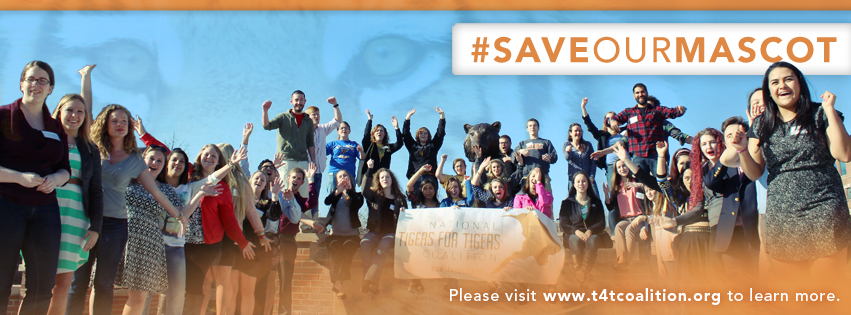 |
| Kevin O'Day on far left with other members of T4T |
Kevin O’Day is sophomore at
SUNY-Cobleskill pursuing a degree in wildlife management. He is also the
founder of SUNY-Cobleskill T4T. On December 29, 2013 he sits down with Sean
Carnell to talk about the T4T at SUNY-Cobleskill.
Why does all of this matter to
you? Why should the American public care about the conservation?
Kevin:
I think that conservation and
endangered species are going to be one of the most important issues of the 21st
century. If humans cannot learn to live with other species without destroying
them, there is really no way that we are going to survive ourselves. I believe
that college students have an opportunity to change the world and improve it for
all its inhabitants.
How did you find out about Tigers
for Tigers and get started?
Kevin:
I found out about Tigers for
Tigers from one of my professors. He received an email from the National T4T
Coalition last year. Because he know that I am into big cats, he thought that I
would be interested in joining. I have always loved big cats, and from there, I
started a club this year at SUNY-Cobleskill.
Initially, I wasn’t going to
start a club until you contacted me about the importance of developing one on
campus. It will make students more aware of the problem. At the beginning it
was primarily my friends who I asked to join. Now we are working on expanding
our club to other students across campus.
How has your Tigers for Tigers
helped you pursue a career and has it helped you develop your passion?
Kevin:
It definitely has expanded my
knowledge and interest in big cats. Before Tigers for Tigers, I was primarily
interested in big cats in Africa. But getting into tigers, and gaining an
understanding of the current situation, it has made me realize that there are
more problems for big cats than I knew before. I definitely think that the T4T
club will help raise awareness for tigers and help save them from extinction.
Specifically for SUNY-Cobleskill, it will be good, because it is a local
smaller school, it will provide opportunities for others to get a greater
understanding of what is happening in the world outside of New York.
Personally, I believe that the
coalition will also allow me to get professional connections, which may help me
get a job after college.
What are your plans after
college?
Kevin:
I plan on moving to the Congo
rainforest and working in a wildlife park there because I personally believe
that it needs the most help in terms of protecting wildlife.
That sounds incredible, although
dangerous, very exciting! What are your plans for next semester with T4T?
Kevin:
Next semester, I want to start
doing things. This semester we focused on starting our organization. Now, we
can start working on fun activities and fundraisers to that people on our
campus can become more engaged about tigers and learn how they can help.
Do you have any advice for T4T
clubs that are starting out?
Kevin:
I definitely suggest that you
find people that truly care and are interested in the issue. It is also
important to develop a core group before you expand. In other clubs, you see
them get too big too fast and die out because no one is really interested in
the subject.
It that is a very important point
to address. Developing a core group of students is key to starting an
organization at your school. Do you think that Tigers for Tigers is making a
difference for tigers?
Kevin:
The idea to get college students
involved is great. Focusing on political action and Congress is definitely a
way to make a difference to ensure that the people in power, who can make
decisions, are aware of the problems faced by these endangered species.
College students are definitely
able to influence policy decisions. Mobilizing passionate college students is a
great way to maximize the effectiveness and staying power of any movement,
especially those that can take advantage of their idealism. Compared to older
adults who have other obligations like a job and mortgage to pay, college
students, have little to lose and therefore are more likely to try to save a
species in a far-off land.
Can you tell us a little bit
about your experience meeting with Senators and Representatives in Congress
from our trip to Washington DC in June with the National Wildlife Refuge
Association and the International Fund for Animal Welfare? What was it like?
Kevin:
Going to Washington D.C was a great experience for me.
Although the members of Congress and their staff were unaware of the policies
that we were there to talk to them about, they seemed genuinely interested in
what we had to say and were willing to lend their support to our issues. It was very inspiring to learn that members of
Congress are very receptive to the idea of mobilizing college students to save
tigers from extinction and that the coalition has the ability to make a
significant positive difference in this endeavor.
About Us:
Students at SUNY Cobleskill have decided to start a Tigers
for Tigers club and join the National Tigers for Tigers Coalition because we
believe that we have an obligation to save our majestic mascot in their time of
need. By raising awareness about the plight of tigers in the wild, we hope to
mobilize the public to take responsibility of mankind’s actions and reverse the
fortunes of tigers in the wild.
To learn more information about the SUNY Cobleskill Tigers for Tigers, follow
us on Facebook and Twitter or
email Kevin O’Day at kevinoday19@yahoo.com.











.jpg)
.jpg)
.jpg)